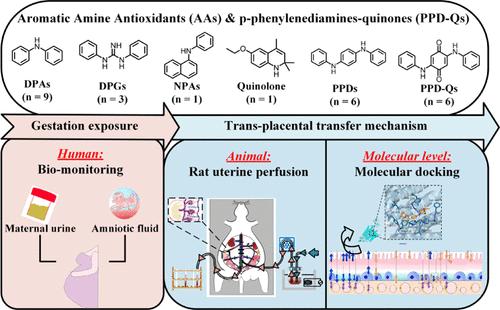当前位置:
X-MOL 学术
›
Environ. Sci. Technol.
›
论文详情
Our official English website, www.x-mol.net, welcomes your
feedback! (Note: you will need to create a separate account there.)
Trans-Placental Transfer Mechanisms of Aromatic Amine Antioxidants (AAs) and p-Phenylenediamine Quinones (PPD-Qs): Evidence from Human Gestation Exposure and the Rat Uterine Perfusion Model
Environmental Science & Technology ( IF 10.8 ) Pub Date : 2024-11-18 , DOI: 10.1021/acs.est.4c09416 Shaohan Zhang, Zhipeng Cheng, Xiaoying Li, Yumeng Shi, Hongkai Zhu, Tao Zhang, Lei Wang, Hongwen Sun
Environmental Science & Technology ( IF 10.8 ) Pub Date : 2024-11-18 , DOI: 10.1021/acs.est.4c09416 Shaohan Zhang, Zhipeng Cheng, Xiaoying Li, Yumeng Shi, Hongkai Zhu, Tao Zhang, Lei Wang, Hongwen Sun

|
Aromatic amine antioxidants (AAs), as rubber additives, and their ozone photochemical oxidation products of p-phenylenediamine quinone (PPD-Qs) have attracted great attention recently due to their wide environmental occurrences and toxicity. However, there is currently no research on the exposure risks during pregnancy and their trans-placental transfer mechanisms. Herein, 20 AAs and six PPD-Qs were analyzed in 60 maternal urine and fifty-six amniotic fluid samples (n = 53 pairs). ΣAAs (median: 8.57 and 15.4 ng/mL) and ΣPPD-Qs (0.236 and 2.29 ng/mL) were both observed, where the median concentration of PPD-Qs was significantly (p < 0.05) higher than that of the parent PPDs (0.130 and 0.092 ng/mL) in the maternal urine and amniotic fluid samples, respectively. The result of the self-established rat uterine perfusion model and molecular docking analysis suggested that passive diffusion and active transport patterns were involved in the trans-placental transfer. This study will raise concerns regarding intrauterine exposure and the trans-placental transfer mechanisms to AAs/PPD-Qs during pregnancy.
中文翻译:

芳香胺类抗氧化剂 (AAs) 和对苯二胺醌 (PPD-Qs) 的经胎盘转移机制:来自人类妊娠暴露和大鼠子宫灌注模型的证据
芳香胺类抗氧化剂(AAs)作为橡胶助剂,其对苯二胺醌(PPD-Qs)的臭氧光化学氧化产物因其广泛的环境发生和毒性而近年来引起了极大的关注。然而,目前还没有关于怀孕期间暴露风险及其经胎盘转移机制的研究。在此,在 60 份母体尿液和 56 份羊水样本 (n = 53 对) 中分析了 20 个 AAs 和 6 个 PPD-Qs。观察到 ΣAAs (中位数: 8.57 和 15.4 ng/mL) 和 ΣPPD-Qs (0.236 和 2.29 ng/mL),其中 PPD-Qs 的中位浓度显著 (p < 0.05) 高于母体 PPD (0.130 和 0.092 ng/mL) 母体尿液和羊水样本。自行建立的大鼠子宫灌注模型和分子对接分析的结果表明,经胎盘转移涉及被动扩散和主动转运模式。这项研究将引起人们对怀孕期间宫内暴露和经胎盘转移到 AAs/PPD-Qs 的机制的关注。
更新日期:2024-11-19
中文翻译:

芳香胺类抗氧化剂 (AAs) 和对苯二胺醌 (PPD-Qs) 的经胎盘转移机制:来自人类妊娠暴露和大鼠子宫灌注模型的证据
芳香胺类抗氧化剂(AAs)作为橡胶助剂,其对苯二胺醌(PPD-Qs)的臭氧光化学氧化产物因其广泛的环境发生和毒性而近年来引起了极大的关注。然而,目前还没有关于怀孕期间暴露风险及其经胎盘转移机制的研究。在此,在 60 份母体尿液和 56 份羊水样本 (n = 53 对) 中分析了 20 个 AAs 和 6 个 PPD-Qs。观察到 ΣAAs (中位数: 8.57 和 15.4 ng/mL) 和 ΣPPD-Qs (0.236 和 2.29 ng/mL),其中 PPD-Qs 的中位浓度显著 (p < 0.05) 高于母体 PPD (0.130 和 0.092 ng/mL) 母体尿液和羊水样本。自行建立的大鼠子宫灌注模型和分子对接分析的结果表明,经胎盘转移涉及被动扩散和主动转运模式。这项研究将引起人们对怀孕期间宫内暴露和经胎盘转移到 AAs/PPD-Qs 的机制的关注。


















































 京公网安备 11010802027423号
京公网安备 11010802027423号